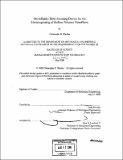Microfluidic flow-focusing device for the electrospinning of hollow polymer nanofibers
Author(s)
Rhodes, Christopher R. (Christopher Randolph)
DownloadFull printable version (2.445Mb)
Other Contributors
Massachusetts Institute of Technology. Dept. of Mechanical Engineering.
Advisor
Todd Thorsen.
Terms of use
Metadata
Show full item recordAbstract
Polymer nanofibers hold much promise as advanced composite materials, and can be customized into matrices with special electrical, optical and biological properties. Electrospinning, which utilizes the destabilization of a fluid's surface in a strong electric field, has gained the most favor as a top-down approach to producing polymer nanofibers. In this work, a microfluidic device was designed and assembled for the two-dimensional focusing of immiscible fluids and integrated into a system for electrospinning. Hollow fibers were produced with diameters on the order of 100-240 nm, at steady-state flow rates around 50 pL/min. TEM images show hollow interiors with diameters approximately one third of the total fiber diameter. These results are important for future efforts at multiplexing the electrospinning process, and prove that the creation of hollow fibers is feasible using a microfabricated device. Furthermore, the focusing of immiscible streams in two dimensions may be used for sample transport and reaction control in microfluidics. Suggestions are made for further evaluation of flow focusing behavior, and improvements that may increase the viability of electrospinning as an industrial process.
Description
Thesis (S.B.)--Massachusetts Institute of Technology, Dept. of Mechanical Engineering, 2006. Includes bibliographical references (p. 52-53).
Date issued
2006Department
Massachusetts Institute of Technology. Department of Mechanical EngineeringPublisher
Massachusetts Institute of Technology
Keywords
Mechanical Engineering.